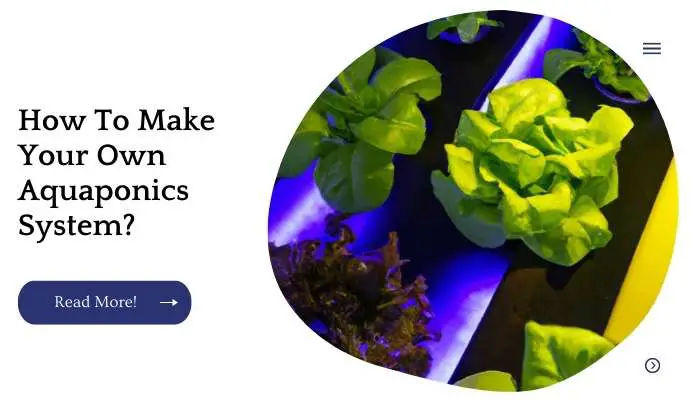Sunday, November 10, 2024
Craft Your Own Aquaponics System for Organic Food at Home

Craft Your Own Aquaponics System for Organic Food at Home
Imagine a self-sustaining ecosystem in your backyard, where fish happily swim and vegetables flourish, all while creating a delicious and organic food source for your family. This is the magic of aquaponics, a system that combines aquaculture (raising fish) with hydroponics (growing plants in water) to create a symbiotic relationship. It's a perfect choice for those seeking a sustainable and eco-friendly way to grow their own food.
This article will guide you through the process of building your very own aquaponics system. We'll break down the key components, the steps involved, and some helpful tips to ensure success. Get ready to embark on a rewarding journey of growing fresh, organic produce right in your home!
Understanding the Basics of Aquaponics
Aquaponics works by mimicking the natural cycles found in wetlands. Here's the magic:
- Fish Waste: Fish produce waste, which is rich in nutrients.
- Bacteria: Beneficial bacteria in the system break down the fish waste into plant-usable nutrients.
- Nutrient-Rich Water: This nutrient-rich water is then circulated to the plant beds.
- Plant Uptake: Plants absorb the nutrients from the water, cleaning it.
- Clean Water: Clean, purified water is returned to the fish tank, completing the cycle.
Essential Components of Your Aquaponics System
To build a successful aquaponics system, you'll need a few key components:
Fish Tank
The fish tank is the heart of your system. Choose a tank size suitable for the number of fish you plan to raise. A 55-gallon tank is a great starting point. Make sure the tank has a reliable filter system to keep the water clean and healthy for your fish.
Grow Beds
Grow beds are where your plants will thrive. You can use various materials, such as recycled plastic tubs, wooden frames, or even repurposed containers.
Pump
A pump is essential for circulating the water from the fish tank to the grow beds and back. Choose a pump with sufficient power to handle the volume of your system.
Pipes and Fittings
You'll need pipes and fittings to connect the fish tank, pump, and grow beds. PVC pipes are a popular and affordable option.
Growing Medium
Unlike traditional hydroponics, aquaponics systems use a growing medium to support the plant roots. Popular choices include clay pebbles, gravel, and expanded clay aggregates.
Building Your Aquaponics System
Now, let's dive into the steps involved in building your aquaponics system.
Step 1: Choose a Location
Select a spot that receives ample sunlight for your plant growth. Ensure the location is protected from extreme weather conditions and easily accessible for maintenance.
Step 2: Set Up the Fish Tank
Place your fish tank securely and level. Install the filter system and any other necessary equipment, like a heater or air pump, depending on your fish species. Let the tank cycle for a few weeks before adding fish.
Step 3: Build the Grow Beds
Construct your grow beds based on your chosen material. Make sure they are watertight and have adequate drainage.
Step 4: Install the Pump
Connect the pump to the fish tank and run the pipes to the grow beds. Test the system to ensure water flow is working correctly.
Step 5: Add the Growing Medium
Fill the grow beds with your chosen growing medium. Ensure the medium is evenly distributed and provides proper drainage.
Step 6: Add Fish
After the tank has cycled, introduce your fish. Start with a small number and gradually increase as needed. Choose fish species that are compatible with your system and thrive in your climate.
Step 7: Plant Your Vegetables
Once the system is running smoothly and the water is balanced, you can begin planting your vegetables. Choose plants that are suitable for aquaponics, such as leafy greens, tomatoes, peppers, and herbs.
Maintaining Your Aquaponics System
Maintaining your aquaponics system is key to its success. Here are some tips:
- Monitor Water Quality: Regularly check the pH, ammonia, nitrite, and nitrate levels in the water. Adjust accordingly to maintain a healthy environment for both fish and plants.
- Feed Your Fish: Feed your fish a balanced diet, ensuring they don't overeat and contribute to excessive waste.
- Clean the System: Periodically clean the fish tank, filter system, and grow beds to remove debris and algae.
- Replenish Water: Top off the water in the system as needed to compensate for evaporation.
Enjoying Your Aquaponics Harvest
Congratulations! You've successfully built and maintained your own aquaponics system. Now, reap the rewards of your hard work by enjoying fresh, organic vegetables grown right in your backyard.
As you gain experience with your system, you can experiment with different fish species, plant varieties, and system designs to find what works best for you. The possibilities are endless. Embrace the journey of sustainable gardening, and savor the delicious flavors of your home-grown harvest.
No comments:
Post a Comment
Note: Only a member of this blog may post a comment.